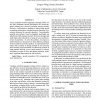ICASSP
2008
IEEE
14 years 7 months ago
2008
IEEE
CALL (Computer Assisted Language Learning) systems using ASR (Automatic Speech Recognition) for second language learning have received increasing interest recently. However, it st...
ICASSP
2008
IEEE
14 years 7 months ago
2008
IEEE
Recently, we successfully developed and reported a new unsupervised online adaptation technique, which jointly compensates for additive and convolutive distortions with vector Tay...
MHCI
2009
Springer
14 years 7 months ago
2009
Springer
We present a technique in which physical controls have both normal and voice-enabled activation styles. In the case of the latter, knowledge of which physical control was activate...
ICMI
2009
Springer
14 years 7 months ago
2009
Springer
In this paper we present a novel system for driver-vehicle interaction which combines speech recognition with facialexpression recognition to increase intention recognition accura...
ICCPOL
2009
Springer
14 years 7 months ago
2009
Springer
Abstract. In a spoken dialogue system, the speech recognition performance accounts for the largest part of the overall system performance. Yet spontaneous speech recognition has an...
IEEEIAS
2009
IEEE
14 years 7 months ago
2009
IEEE
—Ubiquitous network society will be achieved soon. In the society, all electronic equipments including “sensors” are connected to the network and communicate each other to sh...
SEMCO
2009
IEEE
14 years 7 months ago
2009
IEEE
—Techniques for automatic annotation of spoken content making use of speech recognition technology have long been characterized as holding unrealized promise to provide access to...
ICASSP
2009
IEEE
14 years 7 months ago
2009
IEEE
In language modeling for speech recognition, both the amount of training data and the match to the target task impact the goodness of the model, with the trade-off usually favorin...
ICASSP
2009
IEEE
14 years 7 months ago
2009
IEEE
This paper proposes a set of affine invariant features (AIFs) for sequence data. The proposed AIFs can be calculated directly from the sequence data, and their invariance to af�...
ICASSP
2009
IEEE
14 years 7 months ago
2009
IEEE
Features derived from Multi-Layer Perceptrons (MLPs) are becoming increasingly popular for speech recognition. This paper describes various schemes for applying these features to ...






